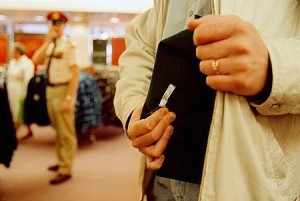 A suspected shoplifter cannot be stopped until he or she is past the last point of purchase. This is fairly standard around the country. Therefore, in most stores, there is a short distance between where a suspect is stopped and the exit to the property. The question is – Can and should the suspect be chased if he/she attempts to flee?
A suspected shoplifter cannot be stopped until he or she is past the last point of purchase. This is fairly standard around the country. Therefore, in most stores, there is a short distance between where a suspect is stopped and the exit to the property. The question is – Can and should the suspect be chased if he/she attempts to flee?
I recently addressed this topic during a presentation on security manuals at DRI’s Retail & Hospitality Litigation and Claims Management Seminar. This issue is relevant when discussing security manuals because sometimes, what is allowed under the law and what is allowed under a security manual regarding the pursuit of suspects can be very different.
The biggest obstacle national retailers’ face with this issue is that state laws are not consistent. If a national policy is created and implemented that prohibits pursuits, the policy will be in compliance with some state laws while creating a heightened duty of care in other states. In contrast, if the national policy allows pursuits, the policy may violate certain state laws. Under either scenario, the internal policy could create trouble, and potential liability, for a retailer.
In the states that allow pursuit of shoplifters, the court’s typically support this finding based on the following analysis:
- the likelihood of very serious injury resulting to customers from a collision with a customer is not great (i.e. not forseeable);
- the likelihood of such an injury occurring is not increased very much because of the guard’s pursuit;
- most shoplifters will flee as quickly as possible when they have been stopped, regardless of whether pursuit takes place;
- the consequence of a rule against pursuit would be a substantial encouragement to shoplifting;
- the duty of the guard/employee is to use ordinary care that he not collide with and injure a customer in the pursuit.
Based on my recent review of case law, not all states have clear case law on this subject. In the following states, there are cases that support a store’s right to pursue a suspected shoplifter in most circumstances: California, Florida, Georgia, Illinois, Louisiana, Maryland, Minnesota, Missouri, Tennessee and Wisconsin. Hulsey v. Safeway Inc., 2005 WL 958411 (California); Graham v. Great Atlantic & Pacific Tea Co., 240 So.2d 157 (Florida 1970); Henderson v. Kroger, Co., 456 S.E.2d 752 (Georgia 1995); Brown v. Jewel Companies, Inc., 530 N.E.2d 57 (Illinois 1988); Butler v. K-Mart, 432 So.2d 968 (Louisiana 1983); Giant Food, Inc. v. Mitchell, 640 A.2d 1134 (Maryland 1994); Hartmann v. Circuit City Stores, Inc., 2008 WL 5137050 (Minnesota 2008); Williams v. Barnes & Noble, Inc., 174 S.W.3d 556 (Missouri 2005); Gantt v. K-mart Corp., 1999 WL 33900761 (Tennessee); Radloff v. National Food Stores, Inc., 121 N.W.2d 865 (Wisconsin 1963).
In other states, courts have found reason to assert that the pursuit of a suspected shoplifter was not allowed and breached a duty of care. Of course, in some of these situations, it could have been the specific facts that lead to the decision rather than the general right to pursuit. The cases that did not allow a pursuit were in: Alabama, Texas, Utah, Washington and West Virginia. Raburn v. Wal-Mart Stores, Inc., 776 So.2d 137 (Alabama 1999); McClure v. Allied Stores of Texas, Inc., 608 S.W.2d 901 (Texas 1980); Steffensen v. Smith’s Management Corp., 820 P.2d 482 (Utah 1991); Passovoy v. Nordstrom, Inc., 758 P.2d 524 (Washington 1988); Ward v. West, 445 S.E.2d 753 (W. Virginia 1994).
So What Is A Retailer To Do?
Good question! After reviewing case law from around the country, my recommendation is to have an internal policy that recommends no pursuit both inside and outside the store. To clarify, I do not recommend that the policy be firm, such as “absolutely, under no circumstances whatsoever and no matter what shall an employee chase or pursue a shoplifter in any way or anywhere.” Such a policy is overly strict and makes it way too easy for the policy to be violated.
Don’t forget that not only is the policy wording important, so is training. Training is an absolute must when it comes to shoplifting apprehension. If the policy states there should be no pursuit both in and outside the store, be sure that is the message being given during training.
I had the absolute thrill of being involved in a shoplifting pursuit at a store a few years back and let me tell you, the adrenaline rush is incredible. It is easy to see how an employee could get overly assertive or aggressive in that type of situation. Remember this, and be sure employees are trained properly so they don’t just react, they act based on training.
Photograph courtesy of: www.shopliftinginformation.com (an interesting read about shoplifting).